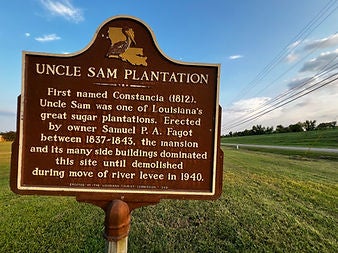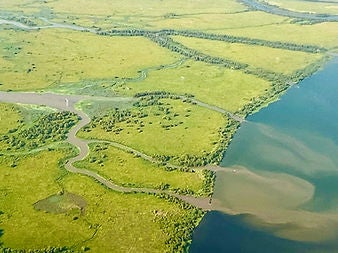The festival was held in New Orleans, Louisiana from July 4th – 6th.
“I tell people all the time that there is blood in the soil, and there’s a lot of blood in the water,” – Harm in the Water
Kingston, R.I. – August 18 – Journalism professor and member of the URI community for the last 22 years, Kendall Moore, and her team walked away with the best documentary award at the Essence Film Festival (EFF). EFF is anchored in the belief that Black stories deserve to be told in their full truth with the intent to disrupt the mainstream narrative.
Moore’s Harm in the Water explores the impact of water pollution on communities along the Mississippi River and helps examine the intersection of environmental justice, history, and science. The pollution stems from chemical plants nestled alongside Black communities and, in turn, presents a concerning and life-threatening health crisis that is blatantly being ignored.
A subject in the documentary questions: “Is there a link between all of these chemical resources that are nestled along the Mississippi River where many folks live?”
The Mississippi River is a major highway that travels through 10 states from north to south. Moore and her team begin their story at the Minnesota Headwaters and make their way south to New Orleans, Louisiana. The film takes the viewer through various locations to talk about why those communities are seeing the impact of contaminants in the river, especially in the Mississippi Delta, through the Gulf of Mexico.

Two major components are actively harming these Black communities that locals are quick to address. The first aspect is aquaculture in the south, and it raises questions about who is affected by the industry. Black community members say, unequivocally, it has depleted oysters and crabs as a food source, and worse, Black fishermen are losing their jobs. In addition to an industry draining resources for an already underserved population, the community is actively being poisoned.
Black people are dying at an alarming rate because of the chemical plant contaminants that include heavy metals. A community just outside of New Orleans is known as “Cancer Alley” due to a significant rise in the disease in that particular area. “Cancer Alley” in Louisiana refers to an 85-mile stretch of communities along the Mississippi River between New Orleans and Baton Rouge, heavily populated with petrochemical plants and oil refineries.
An unbelievable 97% of constituents are affected, and many people believe it is inevitable they will have cancer at some point in their lives. Miscarriages, infertility, severe respiratory ailments, yellow-colored rain, air reeking of chlorine, and children covered in rashes are also commonplace.
While protests are coming from this community, their pleas are being brushed aside. One subject observes that Black engineers are not welcome to engage in the conversation about how to fix this epidemic. Some even consider it a genocide. Further, another subject shares that there’s a feeling that Black voices are not welcome, or that it seems implausible for an individual to be Black and educated to resolve this epidemic based on lived experiences.
“I just want to serve as a conduit for those who do not have the resources or don’t feel comfortable saying certain things because they’re unsafe to say,” Moore said.
Moore was initially approached by Dr. Tiara Moore, estuary ecologist and CEO of Black in Marine Science, because of her two-part series, Can We Talk? The work explores the issue of social belonging in the context of STEM (Science, Technology, Engineering, Math) and the effect it has on the lives of underrepresented people of color (UR-POC) who are pursuing an education or career in STEM, or have decided to leave because of an overwhelming feeling of not belonging.
“Dr. Tiara Moore experienced a lot of racism in her field as a scientist and wanted to make a film that both illustrated and addressed Black communities, and very few to no Black scientists were involved to resolve the issue,” said Kendall Moore.

Thus, the beating heart of this documentary poses that question: What can we do to effect change? Kendall Moore makes all of her films to be a centerpiece of conversation and bring people to the table to start having difficult conversations. However, the state of Louisiana, in particular, makes this effort difficult. The state has legally barred black communities from using racism as a defense via the EPA, even when all evidence points toward the obvious.
The EPA functions to protect people against health risks and enforces environmental regulations. However, the EPA is weaponizing Title VI of the Civil Rights Act of 1964 to address environmental racism and injustice. The federal law prohibits anyone who receives federal funds from discriminating based on race or national origin.
Per Layla Bakhoukh-Choy of The Global Network of Human Rights and Environment, when a polluting corporation wants to build a facility in Louisiana, it must obtain a permit from the Louisiana Department of Environmental Quality (LDEQ) under the Clean Air Act. Yet a 2022 study by Research Scientist Dr Kimberley Terrel and Researcher Gianna St. Julien revealed that the LDEQ’s permitting standards allowed industrial emissions to be 7 to 21 times higher in communities of color.
While there are many factors at play, giving this community a platform is a groundbreaking step in the direction of awareness and change. Earning this award could move the needle in the right direction.
“I feel pleased with our efforts because the communities we worked with were able to make the statement that they wanted to make,” said Moore.
Beyond her academic career, Moore is an award-winning director with over 30 years of experience in documentary film production and television news. Harm in the Water was funded by the National Science Foundation to create quality programming focusing on anti-racism, environmental, and scientific issues.
Bakhoukh-Choy’s work “A Horror Story” – How the Law Simultaneously Addresses and Facilitates Environmental Racism in ‘Cancer Alley’ is available on The Global Network for Human Rights and the Environment website.

